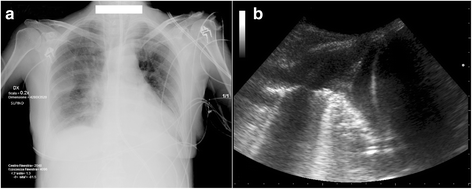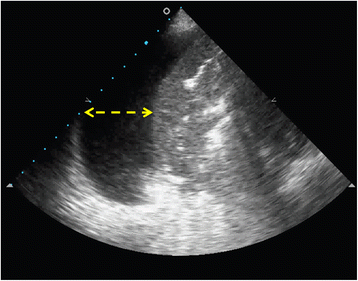Thoracic ultrasound for pleural effusion in the intensive care unit: a narrative review from diagnosis to treatment
- PMID: 29282107
- PMCID: PMC5745967
- DOI: 10.1186/s13054-017-1897-5
Thoracic ultrasound for pleural effusion in the intensive care unit: a narrative review from diagnosis to treatment
Abstract
Pleural effusion (PLEFF), mostly caused by volume overload, congestive heart failure, and pleuropulmonary infection, is a common condition in critical care patients. Thoracic ultrasound (TUS) helps clinicians not only to visualize pleural effusion, but also to distinguish between the different types. Furthermore, TUS is essential during thoracentesis and chest tube drainage as it increases safety and decreases life-threatening complications. It is crucial not only during needle or tube drainage insertion, but also to monitor the volume of the drained PLEFF. Moreover, TUS can help diagnose co-existing lung diseases, often with a higher specificity and sensitivity than chest radiography and without the need for X-ray exposure. We review data regarding the diagnosis and management of pleural effusion, paying particular attention to the impact of ultrasound. Technical data concerning thoracentesis and chest tube drainage are also provided.
Keywords: Catheters; Critical care; Lung; Pleural effusion; Ultrasonography.
Conflict of interest statement
Authors’ information
Not applicable.
Ethics approval and consent to participate
Not applicable.
Consent for publication
Not applicable.
Competing interests
The authors declare that they have no competing interests.
Figures






Similar articles
-
Use of lung ultrasound for the diagnosis and treatment of pleural effusion.Eur Rev Med Pharmacol Sci. 2022 Dec;26(23):8771-8776. doi: 10.26355/eurrev_202212_30548. Eur Rev Med Pharmacol Sci. 2022. PMID: 36524495 Review.
-
[Volumetry of pleural effusion in multi-morbidity, postoperative patients of a surgical intensive care unit. Comparison of ultrasound diagnosis and thoracic bedside image].Zentralbl Chir. 2000;125(4):375-9. Zentralbl Chir. 2000. PMID: 10829319 German.
-
Safe and Effective Bedside Thoracentesis: A Review of the Evidence for Practicing Clinicians.J Hosp Med. 2017 Apr;12(4):266-276. doi: 10.12788/jhm.2716. J Hosp Med. 2017. PMID: 28411293 Review.
-
Lung ultrasound-guided therapeutic thoracentesis in refractory congestive heart failure.Acta Cardiol. 2020 Sep;75(5):398-405. doi: 10.1080/00015385.2019.1591677. Epub 2019 Apr 6. Acta Cardiol. 2020. PMID: 30955462
-
[Parapneumonic pleural effusions: Epidemiology, diagnosis, classification and management].Rev Mal Respir. 2015 Apr;32(4):344-57. doi: 10.1016/j.rmr.2014.12.001. Epub 2015 Jan 13. Rev Mal Respir. 2015. PMID: 25595878 Review. French.
Cited by
-
Cardiopulmonary ultrasound correlates of pleural effusions in patients with congestive heart failure.BMC Cardiovasc Disord. 2022 Apr 26;22(1):198. doi: 10.1186/s12872-022-02638-1. BMC Cardiovasc Disord. 2022. PMID: 35473674 Free PMC article.
-
The POCUS Consult: How Point of Care Ultrasound Helps Guide Medical Decision Making.Int J Gen Med. 2021 Dec 15;14:9789-9806. doi: 10.2147/IJGM.S339476. eCollection 2021. Int J Gen Med. 2021. PMID: 34938102 Free PMC article. Review.
-
Point-of-Care Ultrasound: Applications in Low- and Middle-Income Countries.Curr Anesthesiol Rep. 2021;11(1):69-75. doi: 10.1007/s40140-020-00429-y. Epub 2021 Jan 6. Curr Anesthesiol Rep. 2021. PMID: 33424456 Free PMC article. Review.
-
Role of VATS-US in identifying and characterizing pulmonary nodules: a narrative review.Front Surg. 2025 May 20;12:1567390. doi: 10.3389/fsurg.2025.1567390. eCollection 2025. Front Surg. 2025. PMID: 40463619 Free PMC article. Review.
-
Acute Respiratory Failure in Children: A Clinical Update on Diagnosis.Children (Basel). 2024 Oct 12;11(10):1232. doi: 10.3390/children11101232. Children (Basel). 2024. PMID: 39457197 Free PMC article. Review.
References
Publication types
MeSH terms
LinkOut - more resources
Full Text Sources
Other Literature Sources
Medical

